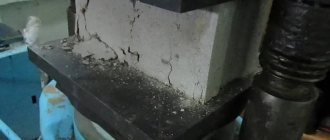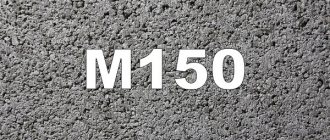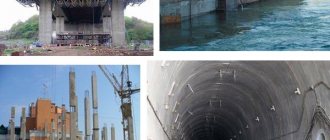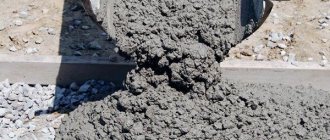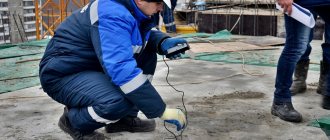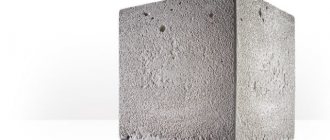Before starting construction, it is necessary to select concrete that will optimally meet the structural and operational requirements. The main parameter in this case is the grade of concrete - an indicator of the quality of concrete, its strength, frost resistance and water resistance.
Concrete is an artificial stone-like building material, the result of a rationally selected mixture of the main binder (cement, as a rule), aggregates, water and, if necessary, special additives. When compacted, the mixture forms and hardens. Before hardening, the concrete mixture is called concrete mortar. Some types of concrete (for example, asphalt concrete) do not contain water.
What is concrete used for?
Concrete is a basic building material. It is used for the manufacture of:
- prefabricated reinforced concrete and concrete structures;
- monolithic concrete and reinforced concrete structures.
When constructing objects using concrete, their types and grades are determined already at the design stage. For each element in building structures (in foundations, load-bearing walls, columns, piles, internal partitions, sanitary cabins, floors, swimming pools, etc.), types and grades of various concretes appropriate for the purpose must be used.
The scope of application of a wide range of concretes in modern construction is constantly expanding. The most promising are high-strength grades of concrete (heavy/light) and special concrete with special specified physical and technical values of certain parameters, such as:
- low draft and mobility;
- frost resistance;
- durability;
- resistance to possible cracking;
- increased heat resistance;
- protection of human bodies from the negative effects of penetrating radiation, etc.
Frost resistance marking
Such a definition as a brand is the main indicator. Each brand is assigned certain numbers. According to GOST, special grades of concrete are designated: f50, f100, f150, f200, f300. They are grouped into groups depending on the level of operation:
Kawabanga! Mixing concrete mortar in a concrete mixer
Concrete grade for frost resistance.
Types and classes of concrete
The main classification occurs according to the binder material used
and distributes concrete into the following types:
- cement (the most common);
- asphalt (used in road construction);
- limestone;
- gypsum;
- silicate;
- clay, etc.
By the nature and structure of the fillers
:
- heavy or ordinary (volume weight > 1800 kg/m?), with fillers made of crushed stone or gravel of fairly dense rocks, which are used in reinforced concrete or concrete structures that require high strength and density;
- especially heavy (volume weight > 2700 kg/m?), with fillers made of barite, iron ores or metals, used for protection against the negative effects of radiation (from ?-rays) at nuclear power plants, as well as in scientific and military laboratories, at special testing grounds ;
- light (volume weight < 1800 kg/m?) - wood concrete, slag concrete, pumice concrete, etc. - with light, most often porous aggregates, characterized by low thermal conductivity and used for fencing structures and coatings;
- especially light - spongy concrete (foam concrete, aerated concrete) with a volumetric weight not exceeding 500 kg/m?.
According to the reinforcement material:
- concrete with steel reinforcement - reinforced concrete (the most common);
- with unstressed reinforcement;
- with prestressed reinforcement;
- wood concrete;
- reed concrete;
- synthetic fiber reinforced concrete;
- concrete with dispersed reinforcement (with fiber), etc.
According to the consistency of concrete mixtures:
- rigid concrete used for massive monolithic structures;
- plastic concretes used in thin-walled, densely reinforced structures.
By properties:
- Waterproof concrete (English marking “watertight concrete”) is structural concrete that does not allow water to pass through under pressure of 0.2 MPa or more. They are used for mine, hydraulic and transport construction.
- Frost-resistant concrete, confirming its increased frost resistance, designed for a greater number of freezing-thaw cycles compared to non-frost-resistant types of concrete.
- Fire-resistant concrete, with particularly increased fire resistance, can withstand (until the onset of destruction) higher temperatures than non-fire-resistant concrete.
By concreting method:
Shotcrete, obtained by shotcreting concrete solutions on the surface of building structures or forms using a special cement gun.
Classification of concrete grades by strength
Concrete grade is the main indicator of concrete quality. It directly depends on:
- quality of binders;
- on the water-binding (water-cement) ratio;
With an increase in this indicator (water-cement module W/C, most often within acceptable limits, ranging from 0.3 to 0.5), the strength of the concrete under study automatically decreases.
- on the density of the fillers and the density of the concrete itself.
Actual strength is distinguished by certain grades of concrete, which correspond to the ultimate compressive strength of a 28-day sample from each batch produced. For research, a sample is taken - a cube 20x20x20 cm.
Classification of concrete grades
divides them into regular and light:
- ordinary concrete: M25; M35; M50; M75; M100; M150; M200; M300; M400; M500; M600;
- lightweight concrete: M10; M15; M25; M35; M50; M75; M100; M150; M200
Conformity of grades and classes of concrete is established in accordance with GOST 26633-91 “Heavy and fine-grained concrete. Technical conditions".
Download GOST 26633-91 “Heavy and fine-grained concrete. Technical conditions".
Table of the relationship between grades and classes of concrete
This table can be used to convert concrete grade to grade and vice versa. Further in the article you will find tables of correspondence between classes and grades of concrete in terms of strength, frost resistance and water resistance.
| Concrete strength class | The closest concrete grade in terms of strength |
| B3.5 | M50 |
| B5 | M75 |
| B7.5 | M100 |
| B10 | M150 |
| B12.5 | M150 |
| B15 | M200 |
| B20 | M250 |
| B22.5 | M300 |
| B25 | M350 |
| B27.5 | M350 |
| B30 | M400 |
| B35 | M450 |
| B40 | M550 |
| B45 | M600 |
| B50 | M700 |
| B55 | M750 |
| B60 | M800 |
| B65 | M900 |
| B70 | M900 |
| B75 | M1000 |
| B80 | M1000 |
In addition, when classifying concrete, you can use a convenient table of concrete grades according to workability and standard hardness:
| Workability grade | Hardness standard, s | Cone draft, cm |
| Super-hard mixtures | ||
| SZh3 | More than 100 | — |
| SZh2 | 51—100 | — |
| SZh1 | less than 50 | — |
| Hard mixtures | ||
| Zh4 | 31—60 | — |
| Zh3 | 21—30 | — |
| Zh2 | 11—20 | — |
| Zh1 | 5—10 | — |
| Mobile mixtures | ||
| P1 | 4 or less | 1—4 |
| P2 | — | 5—9 |
| P3 | — | 10—15 |
| P4 | — | 16—20 |
| P5 | — | 21 or more |
Increased strength against cold
If the frost resistance class of concrete needs to be increased, this can be done in various ways. Experts offer the following options:
- Reduce macroporosity by increasing the thickness of the mixture and its high-quality compaction when pouring. Strong compaction reduces the volume of voids.
- Reduce the amount of water in the solution by using clean aggregates. Recommended moisture ratio with cement W/C <0.5.
- Pull back the date of the first frost. Over time, the number of voids in concrete decreases.
- Use additives that increase the formation of micropores. Water does not penetrate into them. Additives are salts of carbonic, hydrochloric and nitric acids, calcium. Urea is also mixed in.
- Limit contact with water by waterproofing the concrete surface. For this purpose, facade paints, bitumen, polymer impregnations and mastics are used. When applied, they form a protective film.
The use of aluminous cements, hydrophobic and air-entraining additives also helps to increase frost resistance.
The recommended volume of entrained air is 4–6%. The indicator depends on the quality of the ingredients: the maximum value is set when the aggregate size decreases and the presence of water and cement increases.
Concrete grades by frost resistance
Frost resistance is the ability of a material in a water-saturated state to repeatedly withstand alternating freezing and thawing without showing signs of destruction and without confirming a significant decrease in their strength.
When freezing, water expands and fills the pores in the material, which has a destructive effect on it. Thus, frost resistance mainly depends on the structure of the materials: a higher volume of pores that are accessible to water penetration corresponds to lower frost resistance.
Frost resistance is the most important indicator that determines the quality of concrete as a building material. This indicator is especially important for northern countries with harsh climatic conditions. A huge number of concrete structures are located in the open air, they are moistened when exposed to natural factors, and are repeatedly frozen and thawed. The structures of buildings made of non-frost-resistant concrete lose their load-bearing capacity over time and, subject to surface wear, can receive damage of varying complexity.
The reason for the premature destruction of concrete products is their low frost resistance, that is, the non-compliance of the frost resistance grade used with the necessary regulatory requirements.
The frost resistance grade of concrete is the number of cycles of alternating freezing-thawing of water-saturated samples that does not violate the integrity and does not lead to a change in strength.
High-quality concrete, under normal conditions, should serve no less than a hundred years without any damage visible to humans. And products with insufficient frost resistance for certain purposes of use may appear if the manufacturer violates the regulations, as well as the technological cycle in the manufacture of such products, as well as in the irresponsible absence of constant monitoring of frost resistance.
So, for example, for concrete with guaranteed frost resistance, the most important factors, in addition to the cement content, are: water-cement ratio, type of cement, concrete hardening conditions, the presence of special air-entraining additive components in the formulation and other additional conditions.
The frost resistance of concrete is indicated by the letter “F” and a number from 50 to 1000. The number indicates the number of freeze-thaw cycles that are permissible to preserve the quality characteristics of concrete and its suitability for safe use.
Classification of concrete grades by frost resistance
The table shows the number of freeze-thaw cycles for concrete of a given grade using a given method for determining the grade of concrete.
- The first method takes into account all types of concrete, except concrete for road and airfield pavements;
- With the second method - all types of concrete, except concrete for road and airfield pavements and lightweight concrete with an average density of less than D1500;
- The third method is used for concrete road and airfield pavements.
| Determination method | F35 | F50 | F75 | F100 | F150 | F200 |
| First | 25/35 | 35/50 | 50/75 | 75/100 | 100/150 | 150/200 |
| Second | — | -/8 | -/13 | -/20 | 20/30 | 30/45 |
| Second | — | — | 2 | 3 | 4 | 5 |
| Third | — | 35/50 | 50/775 | 75/100 | 100/150 | 150/200 |
| Third | — | — | — | 5 | 10 | 20 |
| Method for determining strength | F300 | F400 | F500 | F600 | F800 | F1000 |
| First | 200/300 | 300/400 | 400/500 | 500/600 | 600/800 | 800/1000 |
| Second | 45/75 | 75/110 | 110/150 | 150/200 | 200/300 | 300/450 |
| Second | 8 | 12 | 15 | 19 | 27 | 35 |
| Third | 200/300 | 300/400 | 400/500 | 500/600 | 600/800 | 800/1000 |
| Third | 37 | 55 | 80 | 105 | 155 | 205 |
Methods for determining the indicator
In accordance with GOST, there are concrete characteristics that influence and ensure the reliability of the construction of structures under given conditions:
- waterproof;
- strength;
- frost resistance.
There is a regulation for determining the indicator (GOST 10060-2012) of resistance to frost. The technical documentation presents 4 ways to determine this indicator.
Testing concrete for frost resistance involves repeatedly freezing and thawing the mixture. To conduct the study, several samples are taken (baseline and control).
Samples in the laboratory are subjected to repeated cycles of freezing and subsequent thawing. To carry out the tests you need:
- freezing chamber;
- containers with water.
After several cycles of heating (up to +180°C) and freezing (up to -130°C), the strength of the material is measured. A concrete strength test is considered positive if the sample retains its qualities.
Research carried out in laboratories is not highly accurate: sometimes the test sample is destroyed, but when used in natural conditions it retains the necessary strength. In the laboratory, the material is subjected to maximum impact, which leads to faster destruction.
To determine the frost resistance of concrete, pay attention to the appearance and condition of the solution:
- the presence of large grains, delamination, the appearance of cracks and stains indicate insufficient quality of the product and low frost resistance;
- cracking under the influence of the sun's rays also indicates insufficient resistance to low temperatures;
- the appearance of cracks confirms weak frost resistance.
You can determine this indicator using the accelerated method. To do this, the sample is placed in a sodium sulfate solution for 1 day. After this, it is dried for 4 hours at +100°C. Repeat the manipulation 5 times; there should be no cracks on the sample. At this point, the frost resistance test of concrete is considered complete.
The frost resistance characteristic becomes most important for foundations in soils with high moisture levels, during the construction of bridges and other hydraulic structures.
Concrete grades based on water resistance
The water resistance of concrete is responsible for the resistance of the material to the destructive properties of water during alternating processes of wetting and drying. This indicator can be calculated by the method of relating the limits of the compressive strength of a material, carried out based on several specific cycles of moistening and drying, and its initial strength.
The brand designation for water resistance is the Latin letter “W” with a number in the range 2-20, for example, W4. The number indicates the maximum allowable water pressure.
Application of suitable grades of concrete for various construction projects
When constructing objects using an industrial method, ready-mixed concrete is used, which has the following markings given in the table:
When producing high-quality ready-mix concrete, strict dosing of the components of concrete mixtures occurs. This serves as a guarantee of the strength and durability of future buildings.
The cost of ready-mixed concrete is determined by the composition and proportions of the components.
Ready-mixed concrete is widespread and is becoming even more popular due to its use in monolithic buildings and structures. The main differences between concretes - reliability, seismic resistance, absence of technological seams, uniform shrinkage and low price - determine their use:
- when pouring walls and foundations using formwork, which allows obtaining strict forms of given monolithic structures;
- when creating floors made of concrete or reinforced concrete, reinforced with steel frames, providing increased resistance to loads;
- during the construction of hydraulic structures, including the production of a variety of swimming pools of any size and level of complexity;
- when used as a cushion under the road surface when laying roads of different sizes;
- during the construction of various platforms, concrete blind areas, sidewalks and garden paths.
